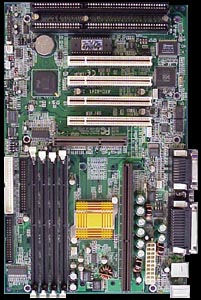Hardware
Audio
Controllers
General
Mainboards
Memory
Modems
Monitors
Portables
Printers
Processors
Scanners
Storage
Video
Games
Reviews
Previews
Cheats
& Hints
News
General Info
About
Us
Advertising
Awards
Contact
Us
Hot
Links
| A-Trend ATC-6241 Manufacturer
A-Trend Expansion Slot : 4/2/1 Did
we mention the strange fixation motherboard manufacturers have with
the letter A? Probably just so that they'll be in the lead when
people list them alphabetically, like we're doing now. Well, A-Trend
isn't in luck there since Abit, AOpen and ASUS have had their turn,
but A-Trend is certainly striking gold with this board, the 6241.
The 6241 follows the classic 4/2/1 PCI/ISA/AGP configuration. Needless to say, a fifth PCI slot would be welcome, but it's understandable that something had to give after the inclusion of the integrated sound chip. On the other hand, the integrated sound chip is pretty much what we've come to expect (unfortunately enough) from integrated sound chips- it's not very good.
When it comes to overclocking, this is a very good board. The only real downer is that it lacks voltage manipulation, but in every other sense this is practically meant for overclocking. We ran a Pentium III 450 at 558MHz with a TennMax P3TF cooler at 124MHz with no problems at all. We also managed to get a classic Celeron 300A up and running at a 112MHz bus speed. Of course, we were using CAS-2 PC-100 memory but even then, the motherboard was very stable at 112 and 124MHz. At 133MHz, of course, it's your usual story- this is where the board moved out of absolute rock-solid country, but it was still quite impressive. Keep in mind, at 133MHz we switched PC-133 memory for the PC-100 modules. A word or two about performance- to complement its sheer overclockability, the board also performs extremely well. This is definitely a board not to ignore, especially when considering its price. It's highly stable, very overclockable and performs well under pressure. The only features missing are manual selection of AGP clock ratios, voltage manipulation and, dare we say it, a fifth PCI slot. Otherwise, watch this board.
|
|
|
|
|

